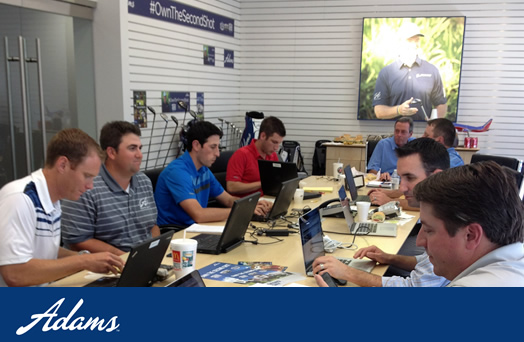Instruction
Q&A: Advice For Beginners From Mike Wydra

As a beginning golfer that is addicted beyond obsession with this wonderful sport, the search for nuggets of knowledge and insight into how to become a better player has been a passion of mine.
I was extremely fortunate that early in my struggles, I became a student of Coach Mike Wydra, UCSD head golf coach and one of a select few inductees to the Golf Coach Association Hall of Fame.
I recently sat down with him to pick his prodigious golf brain on just HOW a beginning golfer should approach learning the game, something I feel that has been somewhat neglected in existing literature.
Neil Crutchfield: First thing I wanted to ask you, what should beginning golfers be most aware of?
Mike Wydra: Golf is a technique-oriented game and people who have good hand-eye coordination don’t always excel at it. Probably the worst student I ever had was an Olympic decathlete who was a fantastic athlete but who wasn’t a good listener. He wanted to do what he felt was correct and he wasn’t interested in the technique — he thought he could conquer it like he’d conquered everything else, and so he became really quite a bad player as a result. So once you understand that there is a very specific technique, that there is something that you need to do and you need to learn it and you’re enamored with that, that’s a big deal.
NC: It sounds like you have to be really open to being wrong for a long time before you get it right.
MW: It’s a very frustrating sport — if you can’t take a little failure, golf’s not for you. I think that’s why you see so many people in the game who are of high character. They’ve gone through that. They understand that they have to persevere and you’ll come out the other side a better golfer and maybe even a better person because of it.
NC: Along these lines, what mindset should a beginning gofer adopt when striking out to learn the game? What kind of expectations?
MW: I think they key to that is where you are in your life. Your age, your body size and type, your flexibility, your coordination those kinds of things. How quick, fast and strong are you? If your talent set is limited there’s certainly lots of things you can still do to be very good at it, you shouldn’t sell yourself short. It depends upon more than anything else on your goals, what you want to do, and how often you’re willing to practice to get it done.
Your expectations — I’m borrowing this from Hogan’s book — that anyone of average body type, size and intelligence and who goes about it seriously I think should have no problem breaking 80 within a relatively short time. I would say between a year and two is very reasonable.
NC: What are common pitfalls that most beginning golfers encounter?
MW: Adults when they take the game up and they don’t want to embarrass themselves on the first tee. What happens to them then is that they get good enough at their long game quickly enough so that they could play if they had a short game, but actually they have just waited to embarrass themselves until they get to the green! It’s almost more frustrating to be right there and you can’t close the deal. So, all aspects of your game need to rise simultaneously.
NC: So you think there should be about a 50/50 split in practice between irons/woods and short game?
MW: I would say that the better you get the more time you spend within 50 yards of the green and certainly if you’re interested in scoring that’s a big, big part of what you need to do. You should get 50 yards away and say, “Oh boy, now I’m going to show everybody.” And most people get close to the green and say, “Oh no I hope I don’t mess it up.”
NC: Please don’t skull it!
MW: Exactly! So what I tell most people is that when you’re at the range you should hit half of your balls with your most lofted wedge and your driver and then the other half of the balls you should hit with all of your other clubs combined. And putting is another thing unto itself. The driver and the shortest wedge, those are the things you’ll need the most.
NC: At what point in a golfer’s learning process should they begin taking lessons? Getting fitted for a set of clubs?
MW: Well, it depends. Obviously there’s the monetary thing. But if you begin by playing poorly, if you just do what’s natural and you go out there and see how good you are before you get lessons, basically what happens is that you develop bad habits and then when the instructor gets you, the process is both getting the bad stuff out and the good stuff in at the same time which slows things down.
Club fitting — when you first get started you’re going to be very hard on your golf clubs. Your first set of clubs, it’s not that important to have really good clubs. A good piece of advice: It’s better to get a high-quality brand of club that’s used rather than something that’s shiny and new but maybe low quality.
NC: What should a beginning golfer look for in an instructor when looking for lessons?
MW: I think almost universally the best combination is someone who can play and someone who can teach. If you can find an instructor who you’ve checked out their resume and you know that they have played at a high level and they’ve taught at a high level, so you look at do they have successful students who have won tournaments? That’s the best possible combo.
NC: What are the most important principles to developing a solid, repeatable swing?
MW: All of the best players in the world have certain things in common. So if you see a Jim Furyk and you see a Rory McIlroy and you see the two swings and you think “Oh my god nothing could be more different than those two swings!” I would say that if you looked at them from halfway down in the downswing to halfway through the follow-through they look almost exactly the same. So if you look at videos and sequence photos and you see that one person’s doing one thing and that another person’s doing another thing, well then that’s style. But if you see them and everyone’s doing the same thing, that’s fundamental.
NC: What you say your top three to five most important fundamentals are?
MW: Grip, absolutely. There’s an old saying that occasionally you’ll see someone who’s a pretty good player who has a bad grip but you’ll never see someone who has a good grip that isn’t a good player.
If I go out to dinner with someone that says they’re a golfer I say “Show me your grip” — I can tell them normally within a shot or two what their index is just by looking at it. They always seem shocked by that but really it tells a lot about what is going on –- nearly everybody puts their hands on the club either poorly or improperly and they’re making it harder for themselves.
Second –- everyone is a scooping bastard. I mean, if you’ve ever taken a shoveful of dirt and thrown it over your shoulder or flipped a burger on a grill your hand-eye coordination is telling you that ball that you just topped you need to get under the next one better — and that’s exactly the opposite of what you need to do.
And that speaks to the flat left wrist. If you’re going to be ahead of it the only way that you can square the club up with a good grip is to change your wrist as you go through –- to supinate your wrist. If we went to Torrey Pines today and we saw high-speed photos of everyone hitting the ball off the first tee, we might not see a perfect one all day. But if you went to the final round of a PGA Tour event and took high-speed photos you wouldn’t see one all day long that wasn’t absolutely perfect.
NC: How can beginning golfers learn how to learn in between lessons when our coach isn’t around?
MW: Basically, you have to be a good observer. The tendency is to have an emotional reaction to every shot you hit. You cannot be mad, you cannot be sad, you cannot be glad about anything. But to first say, “What did the club do the ball to make the ball do that?” and then to understand the physics of impact and secondly say, “What did my body do to make the club do what it just did?” If you just jump from the shot right back to your swing it can be very confusing to the beginning player. So you have to really stop and say, “Woah, what just happened there? I sliced it that much, the club was that open? OK now, what could I have done that could have made the club be that open?”
So be a good observer, understand the physics of impact and then once you know the cause and effect relationships you can make big, very valid adjustments quickly and easily.
NC: What parting advice would you like to give to my fellow newbie golfers?
MW: A little knowledge is dangerous. You should try to learn everything you can about the game, really become a student of the game so you’ll enjoy every practice session you have, you’ll get better every time you go out, and you’ll continue to learn and continue to improve really for your entire life. That’s the thing -– if you don’t know why you hit a bad shot, you’ll continue to hit the bad shots. So if you’re not interested in knowing as much as you can about the game, we’ll just have another beer, buy the newest driver that’s out there…
NC: Flirt with the cart girl…
MW: That whole kinda thing. A lot of people say, “Ahh I’m just out for the exercise.” What a load of bull that is. Everybody would give almost anything to get better but they’re afraid to take their ego and put it on the backburner. So if you really want to approach the game properly get some quality instruction and enjoy the process of getting better, and you’ll be a golfer for life.
Instruction
The Wedge Guy: Beating the yips into submission

There may be no more painful affliction in golf than the “yips” – those uncontrollable and maddening little nervous twitches that prevent you from making a decent stroke on short putts. If you’ve never had them, consider yourself very fortunate (or possibly just very young). But I can assure you that when your most treacherous and feared golf shot is not the 195 yard approach over water with a quartering headwind…not the extra tight fairway with water left and sand right…not the soft bunker shot to a downhill pin with water on the other side…No, when your most feared shot is the remaining 2- 4-foot putt after hitting a great approach, recovery or lag putt, it makes the game almost painful.
And I’ve been fighting the yips (again) for a while now. It’s a recurring nightmare that has haunted me most of my adult life. I even had the yips when I was in my 20s, but I’ve beat them into submission off and on most of my adult life. But just recently, that nasty virus came to life once again. My lag putting has been very good, but when I get over one of those “you should make this” length putts, the entire nervous system seems to go haywire. I make great practice strokes, and then the most pitiful short-stroke or jab at the ball you can imagine. Sheesh.
But I’m a traditionalist, and do not look toward the long putter, belly putter, cross-hand, claw or other variation as the solution. My approach is to beat those damn yips into submission some other way. Here’s what I’m doing that is working pretty well, and I offer it to all of you who might have a similar affliction on the greens.
When you are over a short putt, forget the practice strokes…you want your natural eye-hand coordination to be unhindered by mechanics. Address your putt and take a good look at the hole, and back to the putter to ensure good alignment. Lighten your right hand grip on the putter and make sure that only the fingertips are in contact with the grip, to prevent you from getting to tight.
Then, take a long, long look at the hole to fill your entire mind and senses with the target. When you bring your head/eyes back to the ball, try to make a smooth, immediate move right into your backstroke — not even a second pause — and then let your hands and putter track right back together right back to where you were looking — the HOLE! Seeing the putter make contact with the ball, preferably even the forward edge of the ball – the side near the hole.
For me, this is working, but I am asking all of you to chime in with your own “home remedies” for the most aggravating and senseless of all golf maladies. It never hurts to have more to fall back on!
Instruction
Looking for a good golf instructor? Use this checklist

Over the last couple of decades, golf has become much more science-based. We measure swing speed, smash factor, angle of attack, strokes gained, and many other metrics that can really help golfers improve. But I often wonder if the advancement of golf’s “hard” sciences comes at the expense of the “soft” sciences.
Take, for example, golf instruction. Good golf instruction requires understanding swing mechanics and ball flight. But let’s take that as a given for PGA instructors. The other factors that make an instructor effective can be evaluated by social science, rather than launch monitors.
If you are a recreational golfer looking for a golf instructor, here are my top three points to consider.
1. Cultural mindset
What is “cultural mindset? To social scientists, it means whether a culture of genius or a culture of learning exists. In a golf instruction context, that may mean whether the teacher communicates a message that golf ability is something innate (you either have it or you don’t), or whether golf ability is something that can be learned. You want the latter!
It may sound obvious to suggest that you find a golf instructor who thinks you can improve, but my research suggests that it isn’t a given. In a large sample study of golf instructors, I found that when it came to recreational golfers, there was a wide range of belief systems. Some instructors strongly believed recreational golfers could improve through lessons. while others strongly believed they could not. And those beliefs manifested in the instructor’s feedback given to a student and the culture created for players.
2. Coping and self-modeling can beat role-modeling
Swing analysis technology is often preloaded with swings of PGA and LPGA Tour players. The swings of elite players are intended to be used for comparative purposes with golfers taking lessons. What social science tells us is that for novice and non-expert golfers, comparing swings to tour professionals can have the opposite effect of that intended. If you fit into the novice or non-expert category of golfer, you will learn more and be more motivated to change if you see yourself making a ‘better’ swing (self-modeling) or seeing your swing compared to a similar other (a coping model). Stay away from instructors who want to compare your swing with that of a tour player.
3. Learning theory basics
It is not a sexy selling point, but learning is a process, and that process is incremental – particularly for recreational adult players. Social science helps us understand this element of golf instruction. A good instructor will take learning slowly. He or she will give you just about enough information that challenges you, but is still manageable. The artful instructor will take time to decide what that one or two learning points are before jumping in to make full-scale swing changes. If the instructor moves too fast, you will probably leave the lesson with an arm’s length of swing thoughts and not really know which to focus on.
As an instructor, I develop a priority list of changes I want to make in a player’s technique. We then patiently and gradually work through that list. Beware of instructors who give you more than you can chew.
So if you are in the market for golf instruction, I encourage you to look beyond the X’s and O’s to find the right match!
Instruction
What Lottie Woad’s stunning debut win teaches every golfer

Most pros take months, even years, to win their first tournament. Lottie Woad needed exactly four days.
The 21-year-old from Surrey shot 21-under 267 at Dundonald Links to win the ISPS Handa Women’s Scottish Open by three shots — in her very first event as a professional. She’s only the third player in LPGA history to accomplish this feat, joining Rose Zhang (2023) and Beverly Hanson (1951).
But here’s what caught my attention as a coach: Woad didn’t win through miraculous putting or bombing 300-yard drives. She won through relentless precision and unshakeable composure. After watching her performance unfold, I’m convinced every golfer — from weekend warriors to scratch players — can steal pages from her playbook.
Precision Beats Power (And It’s Not Even Close)
Forget the driving contests. Woad proved that finding greens matters more than finding distance.
What Woad did:
• Hit it straight, hit it solid, give yourself chances
• Aimed for the fat parts of greens instead of chasing pins
• Let her putting do the talking after hitting safe targets
• As she said, “Everyone was chasing me today, and managed to maintain the lead and played really nicely down the stretch and hit a lot of good shots”
Why most golfers mess this up:
• They see a pin tucked behind a bunker and grab one more club to “go right at it”
• Distance becomes more important than accuracy
• They try to be heroic instead of smart
ACTION ITEM: For your next 10 rounds, aim for the center of every green regardless of pin position. Track your greens in regulation and watch your scores drop before your swing changes.
The Putter That Stayed Cool Under Fire
Woad started the final round two shots clear and immediately applied pressure with birdies at the 2nd and 3rd holes. When South Korea’s Hyo Joo Kim mounted a charge and reached 20-under with a birdie at the 14th, Woad didn’t panic.
How she responded to pressure:
• Fired back with consecutive birdies at the 13th and 14th
• Watched Kim stumble with back-to-back bogeys
• Capped it with her fifth birdie of the day at the par-5 18th
• Stayed patient when others pressed, pressed when others cracked
What amateurs do wrong:
• Get conservative when they should be aggressive
• Try to force magic when steady play would win
• Panic when someone else makes a move
ACTION ITEM: Practice your 3-6 foot putts for 15 minutes after every range session. Woad’s putting wasn’t spectacular—it was reliable. Make the putts you should make.
Course Management 101: Play Your Game, Not the Course’s Game
Woad admitted she couldn’t see many scoreboards during the final round, but it didn’t matter. She stuck to her game plan regardless of what others were doing.
Her mental approach:
• Focused on her process, not the competition
• Drew on past pressure situations (Augusta National Women’s Amateur win)
• As she said, “That was the biggest tournament I played in at the time and was kind of my big win. So definitely felt the pressure of it more there, and I felt like all those experiences helped me with this”
Her physical execution:
• 270-yard drives (nothing flashy)
• Methodical iron play
• Steady putting
• Everything effective, nothing spectacular
ACTION ITEM: Create a yardage book for your home course. Know your distances to every pin, every hazard, every landing area. Stick to your plan no matter what your playing partners are doing.
Mental Toughness Isn’t Born, It’s Built
The most impressive part of Woad’s win? She genuinely didn’t expect it: “I definitely wasn’t expecting to win my first event as a pro, but I knew I was playing well, and I was hoping to contend.”
Her winning mindset:
• Didn’t put winning pressure on herself
• Focused on playing well and contending
• Made winning a byproduct of a good process
• Built confidence through recent experiences:
- Won the Women’s Irish Open as an amateur
- Missed a playoff by one shot at the Evian Championship
- Each experience prepared her for the next
What this means for you:
• Stop trying to shoot career rounds every time you tee up
• Focus on executing your pre-shot routine
• Commit to every shot
• Stay present in the moment
ACTION ITEM: Before each round, set process goals instead of score goals. Example: “I will take three practice swings before every shot” or “I will pick a specific target for every shot.” Let your score be the result, not the focus.
The Real Lesson
Woad collected $300,000 for her first professional victory, but the real prize was proving that fundamentals still work at golf’s highest level. She didn’t reinvent the game — she simply executed the basics better than everyone else that week.
The fundamentals that won:
• Hit more fairways
• Find more greens
• Make the putts you should make
• Stay patient under pressure
That’s something every golfer can do, regardless of handicap. Lottie Woad just showed us it’s still the winning formula.
FINAL ACTION ITEM: Pick one of the four action items above and commit to it for the next month. Master one fundamental before moving to the next. That’s how champions are built.
PGA Professional Brendon Elliott is an award-winning coach and golf writer. You can check out his writing work and learn more about him by visiting BEAGOLFER.golf and OneMoreRollGolf.com. Also, check out “The Starter” on RG.org each Monday.
Editor’s note: Brendon shares his nearly 30 years of experience in the game with GolfWRX readers through his ongoing tip series. He looks forward to providing valuable insights and advice to help golfers improve their game. Stay tuned for more Tips!


















Nimrod
Jul 25, 2013 at 6:11 am
Man I wish I could’ve been breaking 80 after a year and a half
marc james
Jul 22, 2013 at 3:01 pm
Awesome read. He gives lessons at the range that’s only 5 minutes away from me! Small world. I’ve witnessed him giving lessons to junior players and has a very calm vibe about him. Very nice guy from what I observed.
Neil
Jul 22, 2013 at 3:32 pm
I’m there pretty much every day – and yeah he’s a cool dude. If you take lessons tell him you saw this article. 🙂
naflack
Jul 21, 2013 at 4:01 pm
whats the best way to get your wife to play good golf?
always leave room for optimism by putting it off another year.
Austin
Jul 20, 2013 at 6:59 am
would be interested in hearing/seeing his explanation for a proper grip. thanks.
yo!
Jul 20, 2013 at 8:07 pm
well, you have the vardon, interlocking, baseball, furyk grip, and they can be strong, weak or neutral. everything else is “bad”. oh, and if you’re not jim furyk, the furyk grip is bad. 🙂
Neil
Jul 22, 2013 at 3:33 pm
Near as I can tell it’s pretty much what Hogan espouses in his book, if you have a copy handy.
J
Jul 19, 2013 at 8:46 pm
Way to represent SD